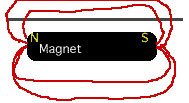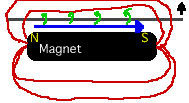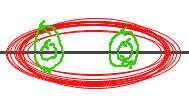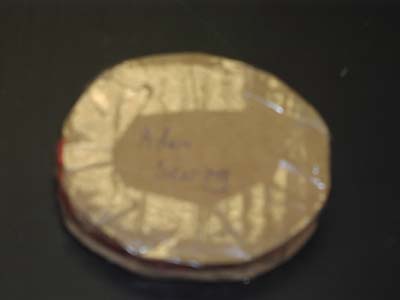The pickup of an electric guitar "picks up" the oscillations of the guitar strings, converting them to electrical signals. These signals are later amplified and converted into sound waves by an amplifier speaker system. This is a description of how a pickup works, and how to build one.
A pickup contains a permanent magnet and magnetic coils. The magnet is placed underneath the metal guitar strings so that when the strings vibrate, they move through the magnetic field.

Drawing of magnetic field around a permanent magnet.
When the metal wire moves through the magnetic field, a current is generated in the wire. This current, in turn, creates a magnetic field surrounding the wire. The flow of the current, and thus the resulting magnetic field, depends on the direction that the string is moving in the magnetic field generated by the magnet. Because the string moves back and forth (just as does a rubber band if you stretch it and pluck it), the magnetic field created by the wire constantly changes direction.


Left image: Drawing of string moving rightward through a magnetic field. Right image: Drawing of string moving leftward through a magnetic field.
Changing magnetic fields induce currents in wires; the changing magnetic field created by the metal guitar string, therefore, creates a current in the magnetic coils that compose the other part of the pickup.

Changing magnetic fields around the guitars pickup.
The current (and voltage) that is produced in the wire coils is transmitted to a speaker system through the circuitry of the guitar; this circuitry is described later in the lab. So now that we know how an electric guitar pickup works, it is time to describe how to build one.
For materials, you need:
- A 4.5 x 2 cm bar magnet
- Two 8 x 11 cm pieces of cardboard
- A large spool of coiling wire; 175 to 200 meters
- Glue (I used wood glue, although the exact type probably doesn't matter too much)
- Packing tape
- A small piece of sand paper
First, glue the magnet into the center of one of the two pieces of cardboard, and glue the other piece of cardboard onto the other side of the magnet so that you have a magnet sandwich.

![]()
Left image: Overhead view of the magnet on the cardboard. Right image: Side view of the magnet sandwich.
The magnet need not be perfectly in the center, but it should be fairly close; it's safe to eyeball the location, though. After the magnet has been glued in place and the glue has dried, cut a short slit about 1cm in from a corner, to hold the wire temporarily. Measure out 60 cm or so of wire from the spool, and leave it hanging out of the cardboard piece; put the 60 cm mark in the slot that you just cut and start wrapping the wire around the magnet, between the two pieces of cardboard. If the wire gets tangled in the cardboard, just untangle it and wrap over any entanglements made by excess wire. Keep wrapping until the wire starts to bulge out the side of the cardboard; this should take several hundred loops. When you are done, run the wire back out through the slit, and leave another trailing 60cm.
At this point, feel free to artistically trim the corners of the cardboard; just be very careful not to cut the wire. The wire coil must be continuous; otherwise, it will not work. Also, run packing tape over the wire coiling for protection. If you cut off the slit that you made earlier, make sure to take the wire out of it; you can just tape the wires in place afterward. Your final pickup should look something like this:

Photograph of home-built pickup.
The next step is to test your pickup. First, you must clean off one or two cm of wire insulation off of the two wire ends that lead out of your pickup. You can do this by sanding the insulation off until the wire has a copper color, or burning the insulation off and sanding off the resultant carbon until the wire has a copper color. Either way, the next step is to connect the pickup to a testing system.
Click here to see how to test a pickup.
